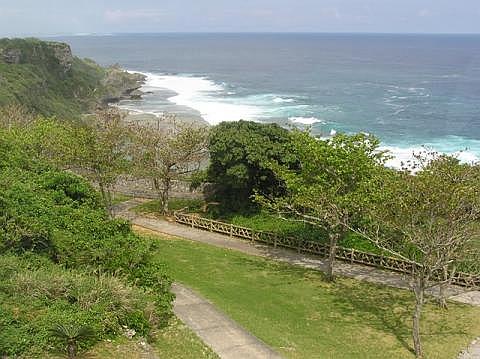
During August of 2003 I was privileged to revisit Okinawa and Kume Jima after forty five years.
One among many highlights of that journey was a visit to the Peace Park Memorial. The park is located in southern Okinawa in Itoman City near Yoza Dake, and on the edge of the sea at a place that is known as "Suicide Cliff." This was a scene of the final fierce Battle of WWII, and the place of so much loss of life. Here too was the scene of death for many Okinawan citizens that committed suicide by throwing themselves from the cliffs.
The park was dedicated in 1972 to commemorate the tragic loss of life and as a reminder of the futility of war. Much of the inspiration and effort to construct the park was provided by Masahide Ota, former governor of Okinawa. The monuments are upright black granite similar to the Viet-nam memorial in Washington D.C. Inscribed upon the walls are the names of those that perished in the terrible battle for Okinawa in 1945. There are over 238,000 names here, consisting of sections devoted to Americans, Japanese, British, Koreans, Taiwanese and Okinawan civilians.
The monuments are upright black granite similar to the Viet-nam memorial in Washington D.C. Inscribed upon the walls are the names of those that perished in the terrible battle for Okinawa in 1945. There are over 238,000 names here, consisting of sections devoted to Americans, Japanese, British, Koreans, Taiwanese and Okinawan civilians.
August on Okinawa can be brutal. Those of us that were there years ago have forgotten how hot it can get. It was such a day when my friend Takeshi Goto kindly took me to the park. The A/C in his vehicle was bravely struggling to keep us cool and only partially succeeding.
At the entrance to the park is a welcome center. We both purchased flowers there to leave at the wall, and more bottled water. There is a wide concrete avenue for pedestrians through beautiful gardens and water features with koi and bog plants. It leads through the walls on both sides down to a unique and artistic fountain. The bottom of the fountain depicts a map of the east china sea and the Ryukyu Island chain, and rising from it is a handsome black granite cone or obelisk. Beyond the fountain is a breathtaking view of the cliffs and the bright azure sea.
After a moment Goto-san left me at the American section where I studied the wall, prayed, and took some pictures.  Eventually I found him a short distance away at another place in the park. He had found the name of his uncle who had been killed in battle here. I had not noticed that he had carried a back pack with us into the park.
Eventually I found him a short distance away at another place in the park. He had found the name of his uncle who had been killed in battle here. I had not noticed that he had carried a back pack with us into the park.
I don't know all of the ritual associated with it, but I know that in Okinawa ancestors are remembered and revered. He was kneeling at the wall and had placed food and drink as well as flowers there when I arrived.
I stepped away, and shortly he joined me at the fountain where we made a few more pictures.
The peace park is a peaceful place, a beautiful place. If I had not known what happened here and throughout Okinawa in 1945 I would have missed much of the experience. Standing on the ground that so recently held the casualties of two armies and so many terrified civilians victims affected me deeply. There is a prevailing quietude here that is almost palpable. If it is possible for the departed to re-visit a temporal battlefield, to whisk unseen among the living, this is such a place.
I kept hearing the sounds of battle and seeing the old black and white film of people throwing themselves from these cliffs. I felt grief that all this had to happen, and yet again, gratitude that there are those among us to preserve these hallowed grounds. That we may come here and to other such memorials around the world to remember the fallen and to pledge, 'never again.'
~ J. London
Page by J London.